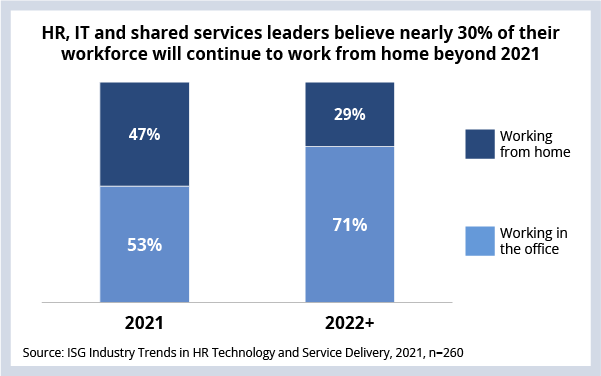|
Future of work
It’s becoming clear that even with 159 million vaccine doses administered across 76 countries, the pandemic recovery will take a long time – and will be unevenly distributed.
That means millions across the globe will continue to work someplace other than the office well past 2021. Our annual global HR Technology and Service Delivery study tells us that nearly 30 percent of the workforce will be working from home in 2022 and beyond (see Data section below).
This is going to have a huge impact on companies as they return to work and build their plans for the future of work. It’s also going to mean a hyper-competitive workplace services market this year as enterprises look to managed services to help them transition into and provide long-term support for the new hybrid working model.
The recent Airbus and HCL announcement is a good indicator of the kinds of workplace deals we’ll see more of this year.
|
|
| |
|
Data
|
 |
|
|
|
| |
|
people
Wipro restructuring continues. CEO Thierry Delaporte continues to flatten Wipro’s organizational chart by replacing seven business units and nine geographies with four market units and two global business lines. Delaporte also continues to bring in new talent. This week, the former head of application management at Atos Michael Seiger was tapped to run the company’s Germany and Austria-based markets, and former AWS executive Douglas Silva was brought in to run its Brazil market.
What does this mean? As we discussed on the most recent Index call, enterprises are rapidly shifting their technology services buying patterns. The tip of the spear is application rationalization and modernization, with the goal of getting the majority of applications on to a cloud. This means Wipro and every other managed services provider need leaders who can sell and deliver cloud-centric application services.
|
|
| |
|
cybersecurity
U.S. water treatment facility is hacked. Late last week, hackers gained access to the control system at a water treatment facility in Florida and attempted to increase the amount of sodium hydroxide in the water supply. Luckily, workers at the plant noticed the change before the water was affected.
The U.S. has around 54,000 water systems, most of which serve fewer than 50,000 residents. Many are underfunded and have put remote access technology in place to enable remote maintenance and monitoring. However, the cybersecurity implications of this connectivity are not always thought through.
What does this mean? Merging operational technology (OT) with information technology (IT) will revolutionize how we manage – and get more life and value from – complex industrial systems. However, when critical systems rely on free remote-connection software with a shared password, the implications can be enormous.
|
|
| |
|
new products
Microsoft makes big bet on experience. Late last week, Microsoft announced the launch of Viva, a new employee engagement and experience platform. This means Microsoft is taking on several highly competitive spaces in enterprise software, including workplace collaboration, enterprise learning and productivity monitoring, to name a few.
Microsoft’s bet appears to be based on the correct assumption that we’ll be working in highly distributed, virtual teams for the foreseeable future – and that we’ll need better ways to connect, learn and measure productivity remotely. However, the spotty adoption of other Microsoft products like Delve shows how hard it is to drive adoption of these kinds of productivity tools. That said, it appears Viva will be primarily served up via Teams, which now has 115 million daily active users, so the landing pad there should help.
We’re likely to get more on Viva at the Microsoft Build conference in the spring or at the Ignite conference in the fall.
|
|
| |
|
Practitioner's POV
More governance = better outcomes. Outcomes are a hot topic in managed services. The goal is to align service providers’ commercial outcomes with the outcomes the buyer wants. For example, in service desk relationships, enterprises want satisfied customers and employees. What satisfies customers and employees when they are working with a service desk? Closed tickets.
But measuring satisfaction based on closed tickets is harder than it sounds. Most service desk agreements today measure the inputs, like number of staff or number of devices, or what those inputs create, like service requests, rather than the desired outcome of the service.
Getting to better outcomes means both enterprises and providers must invest in good governance. Think about it like a ladder – each measurement rung requires progressively better governance, starting with the number of staff, then the number of devices, then the number of service requests, then the number of contacts, and finally, the number of closed tickets.
|
|
| |
|
Deal Activity
- Airbus and HCL. Good example of a workplace services relationship that will ink this year. Link
- Boeing and Dell. Hosting deal for hard-hit aerospace firm. Link
- WINDTRE and Atos. Italian mobile operator signs three-year workstation agreement. Link
- Ford and Google. Six-year agreement makes Google its preferred cloud provider and includes switch to Android Automotive over Apple CarPlay. Link
- FashionCube and CGI. French fashion brand ecosystem signs 10-year full scope ITO deal. Link
|
|
| |
|
mergers, acquisitions, alliances
- Workday acquires Peakon. Big software is focusing on employee experience. Link
- Cognizant buys Linium. Cognizant deepens its already-deep ServiceNow capabilities. Link
- Accenture acquires Imaginea. Fourth AWS/Azure/GCP-focused acquisition in four months. Link
- Ceridian acquires Ascender. Third Asia-Pacific-focused acquisition for HCM software leader. Link
|
|
| |
If you like this content, consider forwarding this email to a friend. And, as usual, feel free to send me a note at [email protected] with your feedback.
Have a great weekend!
|
|
| |
Contributors
Stanton Jones
Alex Bakker
Blair Hanley Frank
Cynthia Batty
Iain Fisher
Julie Fernandez
Mrinal Rai
Sashidharan Balasundaram
|
|

